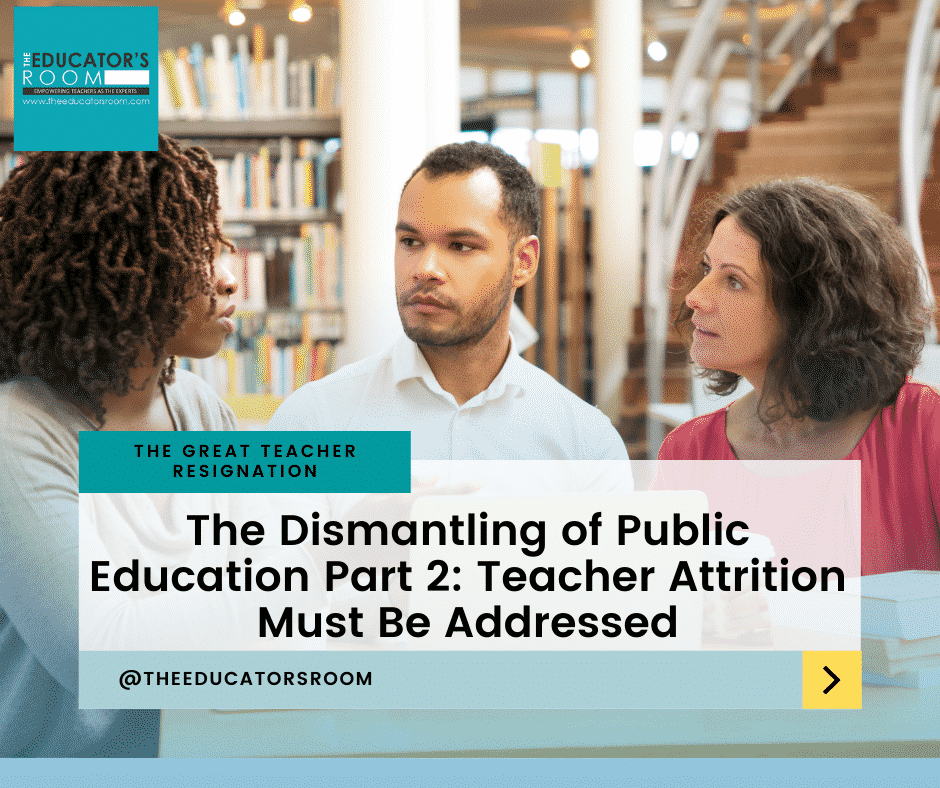Have you signed up for The Educator’s Room Daily Newsletter? Click here and support independent journalism!
It is hard to talk about education these days without broaching the subject of the teacher shortage. While the idea of a teacher shortage has been a looming concern for years in some states, this time it is a legitimate national issue. In what we now know were the early days of the pandemic, there were mass layoffs in many school systems across the country. That seems hard to believe as the teaching shortage crisis is constantly reaching new lows these days.
Ironically, the 2008 housing crisis has played an interesting part in this story. During the Great Recession, about 300,000 school workers lost their jobs, most of which were never to be replaced in the coming years before the pandemic. Those who were not laid off experienced deep budget cuts and multi-year pay freezes. Not to mention the lowered school staff meant larger class sizes, larger workloads, fewer aides, and support roles, among other changes.
As if that weren’t enough, it only gets worse with the pandemic and external factors that have brewed in recent years. We know that more than half of new teachers quit within their first few years of teaching, but with the pandemics shockwaves through education it seems about half of all teachers are considering an exit this year. Between teachers quitting midyear and quarantine sick days, some states have had to call in the National Guard to alleviate the substitute shortages. Meanwhile, education programs across the country’s higher education institutions have seen huge declines in enrollment in the last decade.
How did it get so bad? Typically pay is considered one of the biggest issues in the teaching profession. Over the years, it has become less and less attractive to be a teacher in terms of pay: the gap between teacher pay and comparable workers had gone from 1.8% to 17% in a decade by 2015. Many teachers are realizing their skills are valuable and will be compensated fairly elsewhere.
But even as pay is a huge hurdle, it isn’t the only or most important issue for many teachers. Some districts are realizing that providing mentorship and support staff can help lighten the load of teachers who feel overworked for the pay they are granted. But ultimately even these good faith ideas cannot undo the damage that has been done to the teaching profession.
As mentioned in the introduction of this series, No Child Left Behind essentially coined the dreaded phrase “teacher accountability”. This legislation started the ever-growing snowball that would add to teachers’ plates and continually remind them they had not done enough for their kids. Especially with the pandemic learning loss, disruptions to education, and mounting academic expectations, teachers are burnt out. Teachers lack the support they need while district and government leadership expect gaps to be closed indiscriminately. Not to mention the growing behavior concerns and violence in schools across the nation that is weighing on teachers.
What is most heartbreaking is how the treatment of teachers has gone past the point of no return. Teachers are the scapegoat for every issue in education these days, regardless of if they were even part of the decision-making process. Look at any article about educational issues and the comments will be pinning that issue on teachers, while news pundits refer to “teachers” when they really mean “districts”, “administrators”, or “school boards”.
Accountability has also taken a more sinister turn. Teacher accountability is becoming the new way to police any and everything teachers do in their classrooms. The word indoctrination has been thrown around many times, ironically by those pushing a whitewashed version of events. But most recently, there has been a slew of proposed legislation in red states across the nation that specifically targets teachers: There is one in Oklahoma that would fine teachers $10,000 for teaching anything that contradicts religion and one in Florida seeking to implement cameras in classrooms to ensure educators are not teaching anything that would upset parents. Never mind the fact that the latter opens the door to privacy and safety concerns, plus every public school teacher in the nation is already required to follow their set curriculum.
It’s no wonder teachers are being driven out of the profession. This is a crisis that is going to bubble over – the National Guard is not a long-term solution, and the end of this school year is undoubtedly going to see mass permanent resignations. Fewer teachers mean larger class sizes, less consistency for students, and tougher behavior to be managed by the few who are left. These compounding issues could lead to school closures, less qualified teaching staff, students being funneled to non-public schools, and worsening student outcomes. The legitimacy of public education overwhelmingly hangs on qualified staff, but they deserve better than what schools are offering.






